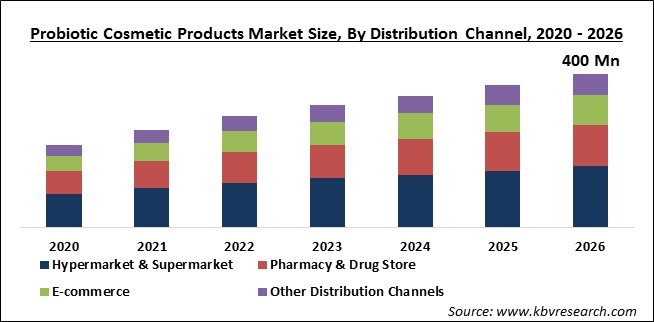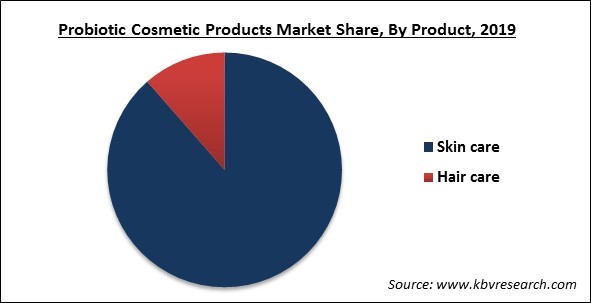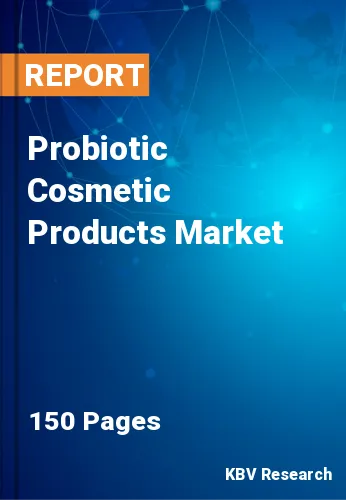The Global Probiotic Cosmetic Products Market size is expected to reach $400 Million by 2026, rising at a market growth of 11% CAGR during the forecast period. Probiotic skincare cosmetic products are considered as beauty products that help in increasing the healing benefits of good microorganisms present in our skin. Such products are also in high demand as they control the natural immune response of the skin and create better skin immunity and resilience. The market of probiotic skincare cosmetic products is witnessing a rising growth graph as these products are really beneficial in maintaining bright skin and aid in preventing issues related to skin.
The market of these products is dynamic with local and global players in the competition in order to gain a leading position. For attaining a competitive advantage over others, the people in this market are always in the pursuit of developing products that are profitable and have a positive impact on consumers. Manufacturers also strive to produce cosmetic products mixed with probiotics and other products to improve the quality of cosmetic products.

The increasing adoption of probiotics as dietary supplement, probiotics witness a massive demand in the cosmetics category, hence boosting the growth of the market. These cosmetic products are beneficial and suitable to all skin types and can assist in reducing problems related to eczema, chronic inflammation, rosacea, and acne.
The industry has been severely impacted by the global COVID-19 pandemic. Various governments have implemented different measures to contain the spread of virus such as Stay-home policy, lockdown measures, and store closures which caused a severe decline in sales. During the pandemic, one of the major observations is that the sentiment of consumers has shifted more toward basic skincare routines and necessities, thus reducing the demand for the probiotic products. Also, the present situation has encouraged customers to step back and choose mass skincare products, which are significantly cheaper and extensively available across all distribution channels.
Based on Distribution Channel, the market is segmented into Hypermarket & Supermarket, Pharmacy & Drug Store, E-commerce and other Distribution Channels. Hypermarket & supermarket acquired the maximum revenue share of the global probiotics cosmetic product market in 2019. The offline stores such as hypermarkets and supermarkets are planning to provide more shelf space to probiotic cosmetic products, which is anticipated to drive the segment growth. Several big retailers, like Sephora and Ulta Beauty, have contributed in giving offline experience to their customers. Sephora has a distinct category for the cosmetic range that showcase probiotics and other supplements.

Based on Product, the market is segmented into Skin care and Hair Care. In 2019, the skin care segment emerged as the dominant segment and held the maximum market share of the global revenue. Probiotics are beneficial to skin problems, such as acne, wrinkles, blemishes, and others, which act as a catalyst for the segment growth. Awareness among people has been increased with respect to the clinically tested products and the effectiveness of probiotics cosmetics which helps to fuel the segment growth. In addition to it, increasing demand for products that will have minimum side effects is likely to boost the product demand in this segment.
| Report Attribute | Details |
|---|---|
| Market size value in 2019 | USD 233.7 Million |
| Market size forecast in 2026 | USD 400 Million |
| Base Year | 2019 |
| Historical Period | 2016 to 2018 |
| Forecast Period | 2020 to 2026 |
| Revenue Growth Rate | CAGR of 11% from 2020 to 2026 |
| Number of Pages | 150 |
| Number of Tables | 260 |
| Report coverage | Market Trends, Revenue Estimation and Forecast, Segmentation Analysis, Regional and Country Breakdown, Companies Strategic Developments, Company Profiling |
| Segments covered | Distribution Channel, Product, Region |
| Country scope | US, Canada, Mexico, Germany, UK, France, Russia, Spain, Italy, China, Japan, India, South Korea, Singapore, Malaysia, Brazil, Argentina, UAE, Saudi Arabia, South Africa, Nigeria |
| Growth Drivers |
|
| Restraints |
|
Based on Regions, the market is segmented into North America, Europe, Asia Pacific, and Latin America, Middle East & Africa. In 2019, North America emerged as the leading region in the probiotics cosmetic product market. The increasing concerns about acne and different skin diseases are expected to boost the probiotics cosmetics demand in this region. Leading manufacturers are focused on product innovation in order to gain a competitive edge in the market.
Free Valuable Insights: Global Probiotic Cosmetic Products Market to reach a market size of $400 million by 2026
The market research report covers the analysis of key stake holders of the market. Key companies profiled in the report include Estee Lauder Companies, Inc., L'Oreal Group, Unilever PLC, The Clorox Company, Health and Happiness (H&H) International Holdings Limited (Aurelia Probiotic Skincare), Esse Skincare, Tula Life, Inc., Eminence Organic Skin Care, Glowbiotics, Inc., and LaFlore Probiotic Skincare.
By Distribution Channel
By Product
By Geography
The probiotic cosmetic products market size is projected to reach USD 400 million by 2026.
There are several reason that cause high demand of this market one of them is increasing popularity for skin treatments among people.
Estee Lauder Companies, Inc., L'Oreal Group, Unilever PLC, The Clorox Company, Health and Happiness (H&H) International Holdings Limited (Aurelia Probiotic Skincare), Esse Skincare, Tula Life, Inc., Eminence Organic Skin Care, Glowbiotics, Inc., and LaFlore Probiotic Skincare.
The hair care segment would exhibit the fastest growth during the forecast period.
The expected CAGR of probiotic cosmetic products market is 11% from 2020 to 2026.
Our team of dedicated experts can provide you with attractive expansion opportunities for your business.

